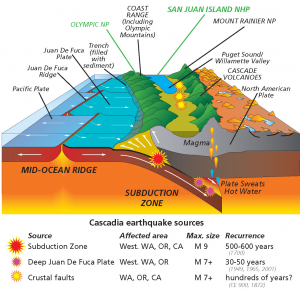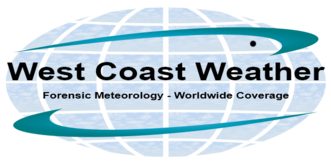Earthquakes: Seattle-Weather-Damages
By Michael FaginGeneral InfoWith 0 commentsEarthquakes: Seattle-Weather-Damages. Can the atmosphere trigger earthquakes? There are multiple kinds of forces derived from atmospheric changes but are they strong enough to influence the movements of the tectonic plates?
Transitions between types of weather – rain, snow, hail, thunderstorms, tornadoes, etc. – have no known effect on earthquakes. Sometimes, however, the reason scientists aren’t yet aware of something is because it’s intensely difficult or even impossible to measure.
Lightning can’t cause earthquakes but earthquakes can cause lightning of many shapes, colors and forms, according to a recent study pertaining to the chemical nature of certain rocks.
Across vast distances, winds can be forceful, with their forces numerically squared over an area. The trouble with concluding that ground level winds are a potential cause is that, typically, they aren’t both intensive and expansive. When they are, there is no well known correlation with earthquakes. Additionally, downward forces tend to get normalized over an area by upward forces.
The idea that winds may possibly trigger quakes has been indirectly tested through nuclear bomb detonations. Over 2,000 have been detonated, many underground. Far fewer have been tested in the atmosphere over earthquake-prone regions and faults. The 1971 Aleutian Islands detonation was one of the few but no seismic activity was recorded. Three years earlier, however, a thermonuclear test over Nevada did produce a shallow, 4,000’ fresh fault.
Kitsap Peninsula 2017
Is it possible for small forces to add up and lead to the triggering of an earthquake? The May 3-4, 2017 swarm of 20 earthquakes at Washington’s Kitsap Peninsula was a good demonstration of a seismic chain reaction. The initial quake, about 1.4 miles north of Bremerton, was a 3.3 on the Richter scale. Beyond being of noticeable but inconsequential size, the area fortunately is only lightly populated

Earthquakes-Seattle Area, and plate tectonics
Geologists know that plate tectonics are the main derivative of earthquakes but it is many accumulated small changes that can lead toward swarms of small earthquakes. Can the atmosphere trigger earthquakes, too? Some have speculated that changes in the weight of the atmosphere during transitions between zones of relatively high and low atmospheric pressure may add or alleviate just enough weight to trigger an earthquake. While such a change alone isn’t sufficient to cause a seismic event – and even many schoolchildren know that forces underneath the crust are the primary cause – some believe they may be the next biggest physical change that may occur over a vulnerable area and, potentially, the proverbial straw that broke the camel’s back. The functional question is: how relevant is the physical change from variations in atmospheric pressure relative to the strength of the forces underground?
Measuring Changes between Air Masses
A few calculations need to be performed before concluding that earthquakes can be triggered by atmospheric changes. On average, a square foot of Earth’s atmosphere from the surface to outer space weighs 176.4 lbs/ft2. A large pressure change, likely over longer than a day, may be from a Low of 960 mb to a High of 1,040 mb, yielding a change of 80 mb. An 80 mb change relative to the average pressure, 1,000 mb, is an 8.0% change. 8.0% of 176.4 lbs/ft2 is 14.1 lbs/ft2 of change between the systems.
What does that mean with respect to the size of an air mass? The contiguous United States is about 3,119,885 mi2. Typically, an established Low or High can occupy half of it: 1,559,942.5 mi2. 1,559,942.5 mi2 x (5,280 ft/mi)2 x 14.1 lbs/ft2 = 6.13 x 1014 lbs.
For comparison, the weight of Mt. Everest is about 3.57 x 1014 lbs. Is the addition or alleviation of a weight 70% heavier than Mt. Everest spread out over an area about six magnitudes larger enough to trigger an earthquake?
Considering the weight of the Earth is about 1.3166 × 1025 lbs – the equivalent of about 3.688 × 1010 Mt. Everests – geological help is likely needed. The dynamics of the core and mantle are similar in ways to the dynamics of a star. Whatever happens deep inside the Earth is still mostly unknown. Bursts of ventilating radiation transport forces that dwarf Mt. Everest by magnitudes because there are, for the sake of comparison, about 36 billion Mt. Everests composing the Earth, smashed together by levels of gravity less forceful than those of a small, cool star.
Some additional questions must also be raised in order to decipher the relevance of an atmospheric change. Is the potential earthquake zone on a large fault? Bigger faults tend to make bigger earthquakes and may better mask any potential effects from changes in the atmosphere.
Is a potential earthquake primarily affected by forces near Earth’s crust or deep below? If one can be triggered by events very near the surface, how close is the area to an earthquake-creating tipping point? If the area is riding on the very edge of tipping, can the atmosphere trigger earthquakes? Perhaps a minute fraction of history’s hundreds of millions may have been meaningfully influenced by weather.
The Relevance of Earthquake Predictions
Many seismologists claim weather doesn’t play a relevant role in practical earthquake prediction; but how accurate are today’s efforts? Like Meteorology, Seismology as a field is also overall in its infancy.
A Professor in the Pacific Northwest recently received national attention for making the first model to successfully predict an impending earthquake. University of Washington’s John Vidale introduced a system called ShakeAlert, which provides a few seconds to up to two minutes of warning before one strikes. The initial Kitsap earthquake was the first correctly predicted by his system. A lot of work needs to be done in improving the accuracy of earthquake predictions but ShakeAlert or a similar system may soon gain a footing in public safety announcements, as a matter of seconds to minutes is far better than no warning. After an initial quake, USGS aftershock predictions, built upon assumptions that one movement may lead to more, can be of use. A truly functional, reasonably accurate predictive system would require an encompassing knowledge of all of the factors that may lead to quakes.
Earthquake Damages
The earthquake itself is merely the first threat to human lives and isn’t known to be murderous. The slew of associated secondary, greater dangers come from damages to the infrastructure: gas lines, water pipes, electrical outages, bridge collapses, crumbling buildings, severed phone lines, etc. A couple minutes of warning may help potential victims flee to safer locations but it’s not long enough to prevent much damage.
Location is everything with earthquakes. They happen nearly daily worldwide but most are in very remote locations. In more than sparsely occupied areas, many millions in damages can be administered in seconds. Densely populated areas can easily experience damages in the billions. The toll of the Jan. 17, 1994 Los Angeles earthquake was a solid $30 billion. PEMCO Insurance found that 77% of residents in the Pacific Northwest expect to experience a big earthquake during their lives but only 52% are somewhat prepared for it, with 39% admitting to not being prepared at all.
Article written by Meteorologist Geoff Linsley
